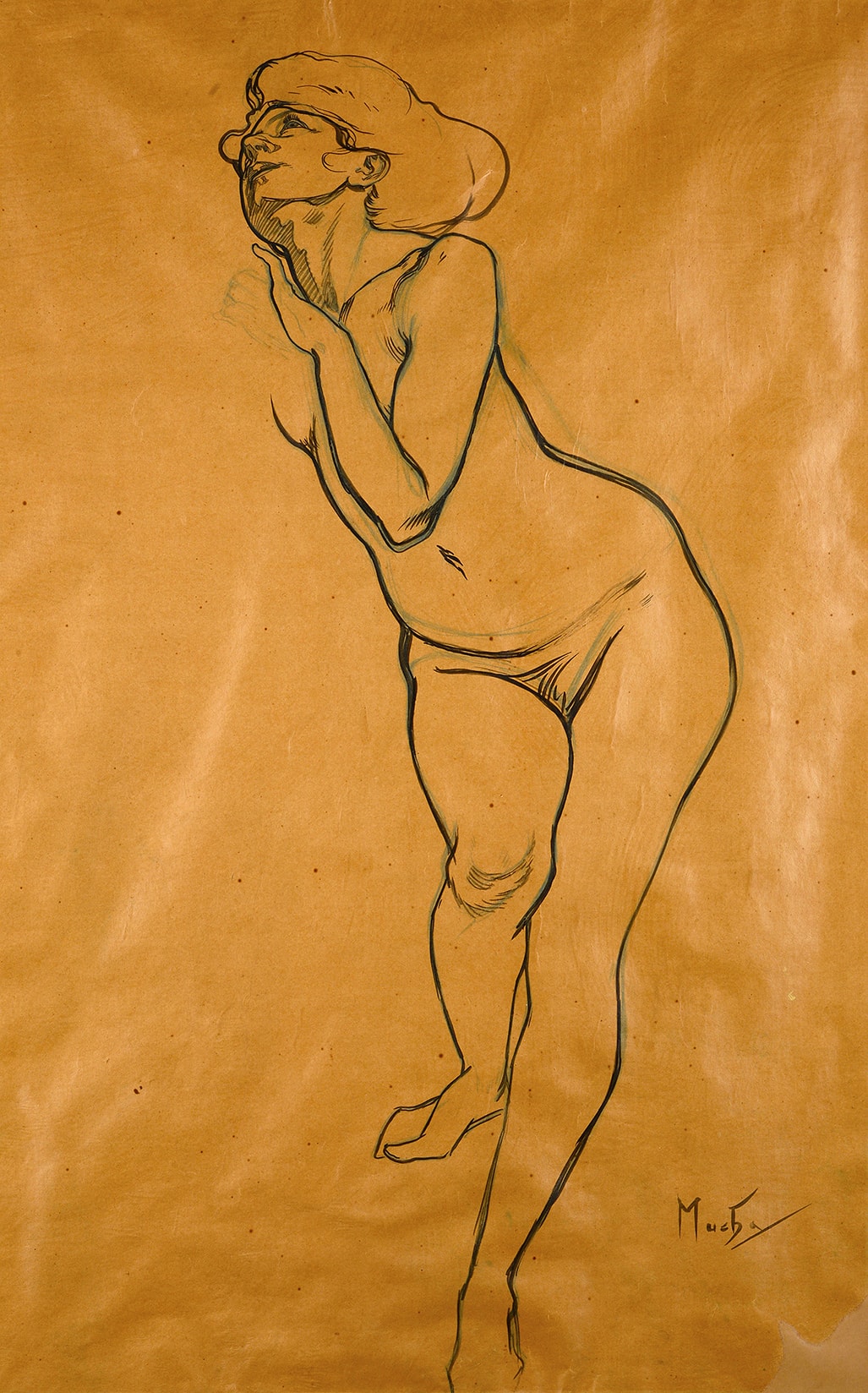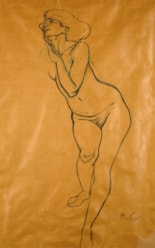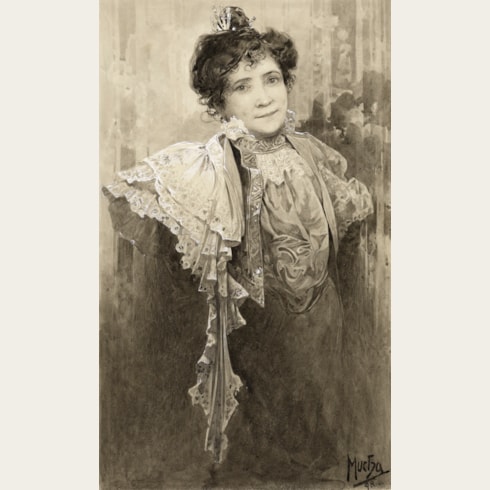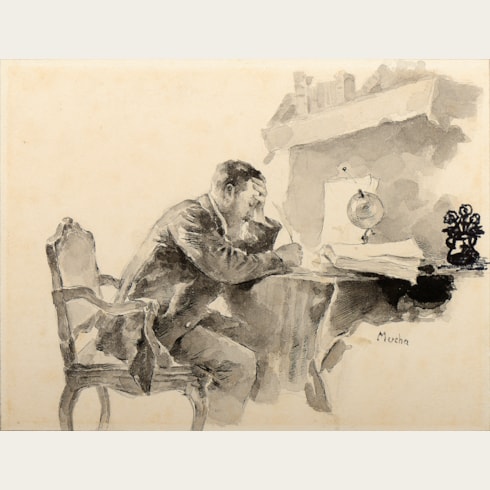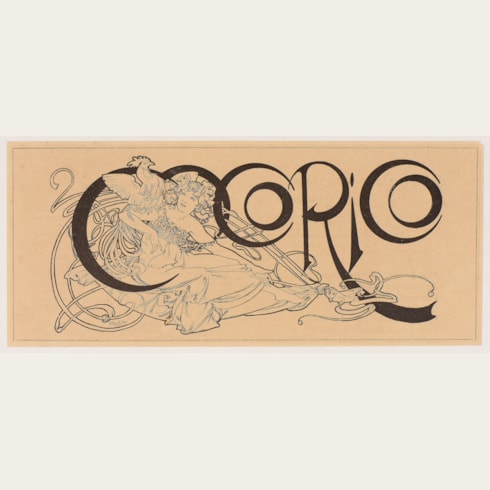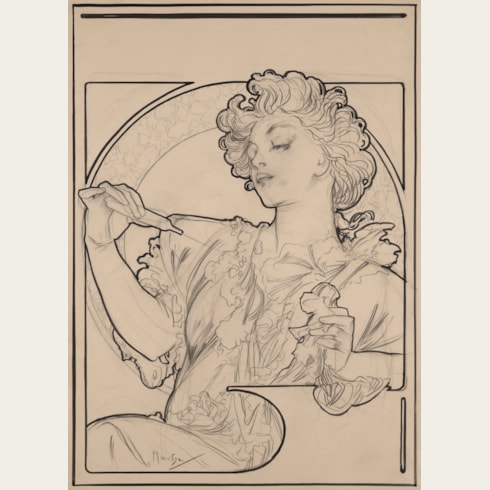Alphonse MUCHA
(Ivančice 1860 - Prague 1939)
A Standing Female Nude (Study for Petronius and Eunice, from Quo Vadis)
Signed Mucha at the lower right.
1300 x 860 mm. (51 1/4 x 33 7/8 in.)
Long thought to be lost, the large painting of Petronius and Eunice, later known as Quo Vadis, has a fascinating history. The canvas was begun around 1904 and was completed by Mucha in Chicago two years later, in 1906, when it is recorded in an old photograph. When the artist returned to Europe, he left the painting with his friend, the architect Hercz. In 1910 the suggestion was made to use the painting as a tapestry design, but that never materialized. On Mucha’s return to America ten years later, he was said to have completely repainted the picture. While The Slav Epic was exhibited at the Art Institute of Chicago in 1920, Mucha consigned the large painting, now entitled Quo Vadis, along with several other works, to a selling exhibition at the long established Chicago picture frame makers Newcomb-Macklin Co. (That the artist must have regarded the painting as highly significant is seen in the fact he priced it at $10,000, roughly equivalent to $125,000 today.)
The painting was unsold, however, and the work remained with Newcomb-Macklin for over fifty years and was soon forgotten. When the Newcomb-Macklin Co. went out of business in 1979, after over a century of dealing in frames, the old canvas, now in ruinous condition and unrecognized for what it was, was given away to a local carpenter. After being identified and passing through several hands, the painting was the subject of a court case which saw the work returned to Jiri Mucha, the artist’s son. The canvas is today in the collection of the city government of Sakai in Japan.
Although the painting of Quo Vadis was long thought to be lost, the basic composition of was known from a smaller watercolour variant - dated July 29th 1904 and measuring 560 x 480 mm. – which is today in a private collection.
Born in 1860 in a small town in southern Moravia, then part of the Austro-Hungarian Empire, Alfons (Alphonse) Maria Mucha led the typical itinerant life of a young artist from Central Europe, studying in Vienna, Munich and finally Paris. His earliest works were in the form of decorative mural paintings, graphic designs for posters and calendars, and illustrations for books, magazines and newspapers. It was Mucha’s brilliant design for a poster depicting the celebrated actress Sarah Bernhardt in the title role of Victorien Sardou’s Gismonda, executed at the end of 1894, which was to secure his reputation. The success of the poster – a landmark of Art Nouveau design - led to a collaboration with the actress which was to last several years. Mucha signed a six-year contract to design posters for all of Bernhardt’s plays, becoming almost as famous as his legendary model. He also received frequent commissions for advertising posters and other commercial projects, each characterized by the artist’s iconic, graceful female form. Soon he had come to be regarded as the successor to the great poster designer and publisher Jules Chéret. Many of Mucha’s posters were widely reproduced as prints and postcards, to be sold to avid collectors and contributing greatly to the artist’s increasing renown and financial success.
In 1897 a large exhibition of Mucha’s recent work was held at the offices of the artistic review La Plume in Paris, accompanied by a special issue of the magazine devoted to the artist. Known as the Salon des Cent, the exhibition showed nearly 450 works by Mucha – including designs for posters, calendars, menus, theatre programs, illustrations, advertisements and so forth - all executed within the previous two years. By this time the prosperous and successful artist was living and working in a large studio on the rue du Val-de-Grâce, where he entertained many of the notable literary and artistic personalities of the day. For the Paris Exposition Universelle of 1900, which launched le style Mucha to an international audience and popularized the Art Nouveau aesthetic with which he was so closely associated, Mucha was commissioned to decorate the Bosnia-Herzegovina pavilion. He began creating remarkable designs for jewelry for the goldsmith and jeweler Fouquet, the interior of whose shop on the rue Royale he also designed.
At the suggestion of Baroness Salomon de Rothschild, Mucha visited New York in 1904 and again in 1905. His reputation having preceded him (a headline in the New York Daily News described him as ‘the Greatest Decorative Artist in the World’), Mucha was widely fêted and soon earned several portrait commissions. He spent several years in America, living and working in Chicago and New York and earning significant prices for his portraits. In 1910, with the financial support of an American patron, Mucha began working on an ambitious and long-cherished project for a series of twenty monumental paintings illustrating scenes from Czech and Slavic history. Known as The Slav Epic, this sequence of enormous canvases, each several metres in length, occupied the artist for eighteen years. The paintings were donated by Mucha to the city of Prague in 1928.
Provenance

